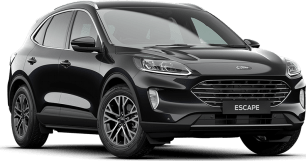On paper, the new Forester hasn’t changed to a great degree. With that engine and the late-ish introduction of a proper hybrid system, you might expect the Forester to be undercooked.
Sure, Subaru is playing catch-up and it would be a fair to say adding a hybrid grade to its mid-size SUV in 2025 puts it behind the curve, but Subaru is leaning into its niche.
Subaru’s very happy about being able to claim the Forester is the only hybrid mid-size SUV on sale where the one hybrid motor drives all four wheels mechanically thanks to its 'symmetrical' all-wheel drive system. Then there’s the "class-leading" 220mm of ground clearance.
But as well as being capable off the road, the Forester needs to be a decent day-to-day companion. Fortunately, it’s both.
The new Forester’s road manners are a surprising step-up over the previous generation’s, which felt soft and agricultural at times.
Subaru touted the new car's incremental improvements, but behind the wheel it feels like they add up to a far superior experience. The Forester is still a little noisy - mainly wind and road noise - but many of the elements that were once a let-down are much more refined.
The CVT doesn't complain so much when called upon to pick up the pace, and the steering feels much sharper. The former could be down to a huge increase in sound-shielding, the latter likely due to Subaru’s use of the dual-pinion steering system borrowed from the WRX.
Subaru says it “reduces mechanical resistance and eliminates unwanted feedback from the motor”. It seems to have done exactly that.
Perhaps most noticeable is the suspension, which feels more tied-down and stable than before, without sharpening up too much and becoming uncomfortable. Subaru says revised spring rates, better under-body aero and a more rigid chassis all contribute.
The hybrid and petrol have different suspension set-ups, the latter feeling softer in terms of damper response but still far more confidence-inspiring than the previous-gen Forester.
It all comes together to create a driving experience that’s easy and comfortable at traffic speeds and fun and engaging at high speeds on, for example, the smooth winding back-roads of New Zealand’s South Island.
The problem for Subaru is that despite having introduced a new hybrid system, the petrol-only Forester is just as good from behind the wheel. The advantages the hybrid brings in terms of efficiency will be a draw for some, but in terms of driving dynamics the extra power and torque on offer is probably not worth the extra outlay.
Then there’s the lack of a spare wheel… which should be a requirement when you’re off sealed roads. The gravel and mud of the Canterbury region didn’t faze the Forester, though, and we put the mid-size SUV through its paces harder than most owners realistically would.
Deep mud ruts, creek crossings and jagged rocky trails were all traversed easily and comfortably, especially considering the standard road tyres fitted.
None of the test cars were stuck due to either negligent road testers or lack of mechanical ability on the Subaru’s part, though two cars on test did succumb to an excess of water in the engine bay and went into a safety shut-down mode once we arrived back at the end of the off-road trail.
We asked Subaru for an explanation and we were told it’s a feature that saves components like the cooling fan from water damage.
“Two vehicles experienced this due to the nose being submerged from entering the water crossing at the incorrect speed and/or entry line… if water enters the engine bay at a sufficient level, a protective fuse is designed to engage to safeguard the radiator fan motor.
“This system functioned exactly as designed. Despite this, the vehicle continued to perform as intended, enabling the driver to complete the off-road course and return safely to the Homestead.
“After cycling the ignition, a warning light alerted the driver, and the engine shut down automatically to prevent any potential damage. This sequence is outlined in the Owner’s Manual. This is a built-in protection protocol and not a fault.”
A replacement fuse meant one of the vehicles “resumed full operation,” a Subaru spokesperson added.











.png)















































.png)























 copy.png)















